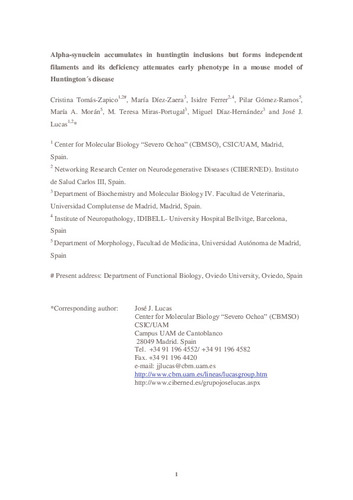α-Synuclein accumulates in huntingtin inclusions but forms independent filaments and its deficiency attenuates early phenotype in a mouse model of Huntington's disease
Otros títulos:
Alpha-synuclein accumulates in huntingtin inclusions but forms independent filaments and its deficiency attenuates early phenotype in a mouse model of Huntington´s disease
Palabra(s) clave:
Neurodegeneration
Huntington´S Disease
Alpha-Synuclein
Polyglutamine
Parkinson´S Disease
Fecha de publicación:
Editorial:
Oxford University Press
Versión del editor:
Citación:
Descripción física:
Resumen:
Huntington’s disease (HD) is the most common of nine inherited neurological disorders caused by expanded-polyglutamine (polyQ) sequences which confer propensity to self-aggregate and toxicity to their corresponding mutant-proteins. It has been postulated that polyQ-expression compromises the folding capacity of the cell which might affect other misfolding prone proteins. α-Synuclein (α-syn) is a small neural-specific protein with propensity to self-aggregate that forms Parkinson’s disease (PD) Lewy bodies. Point mutations in α-syn that favor self-aggregation or α-syn gene duplications lead to familial-PD, thus indicating that increased α-syn aggregation or levels are sufficient to induce neurodegeneration. Since polyQ-inclusions in HD and other polyQ-disorders are immunopositive for α-syn, we speculated that α-syn might be recruited as an additional mediator of polyQ-toxicity. Here we confirm in HD postmortem brains and in the R6/1 mouse model of HD the accumulation of α-syn in polyQ-inclusions. By isolating the characteristic filaments formed by aggregation prone proteins, we found that N-terminal mutant huntingtin (N-mutHtt) and α-syn form independent filamentous microaggregates in R6/1 mouse brain as well as in the inducible HD94 mouse model, and that N-mutHtt expression increases the load of α-syn filaments. Accordingly, α-syn knock-out results in diminished number of N-mutHtt inclusions in transfected neurons and also in vivo in the brain of HD mice. Finally, α-syn knock-out attenuates body-weight loss and early motor phenotype of HD mice. This study therefore demonstrates that α-syn is a modifier of polyQ-toxicity in vivo and raises the possibility that potential PD-related therapies aimed to counteract α-syn-toxicity might help to slow HD.
Huntington’s disease (HD) is the most common of nine inherited neurological disorders caused by expanded-polyglutamine (polyQ) sequences which confer propensity to self-aggregate and toxicity to their corresponding mutant-proteins. It has been postulated that polyQ-expression compromises the folding capacity of the cell which might affect other misfolding prone proteins. α-Synuclein (α-syn) is a small neural-specific protein with propensity to self-aggregate that forms Parkinson’s disease (PD) Lewy bodies. Point mutations in α-syn that favor self-aggregation or α-syn gene duplications lead to familial-PD, thus indicating that increased α-syn aggregation or levels are sufficient to induce neurodegeneration. Since polyQ-inclusions in HD and other polyQ-disorders are immunopositive for α-syn, we speculated that α-syn might be recruited as an additional mediator of polyQ-toxicity. Here we confirm in HD postmortem brains and in the R6/1 mouse model of HD the accumulation of α-syn in polyQ-inclusions. By isolating the characteristic filaments formed by aggregation prone proteins, we found that N-terminal mutant huntingtin (N-mutHtt) and α-syn form independent filamentous microaggregates in R6/1 mouse brain as well as in the inducible HD94 mouse model, and that N-mutHtt expression increases the load of α-syn filaments. Accordingly, α-syn knock-out results in diminished number of N-mutHtt inclusions in transfected neurons and also in vivo in the brain of HD mice. Finally, α-syn knock-out attenuates body-weight loss and early motor phenotype of HD mice. This study therefore demonstrates that α-syn is a modifier of polyQ-toxicity in vivo and raises the possibility that potential PD-related therapies aimed to counteract α-syn-toxicity might help to slow HD.
DOI:
Colecciones
- Artículos [36354]
- Morfología y Biología Celular [166]
Ficheros en el ítem





